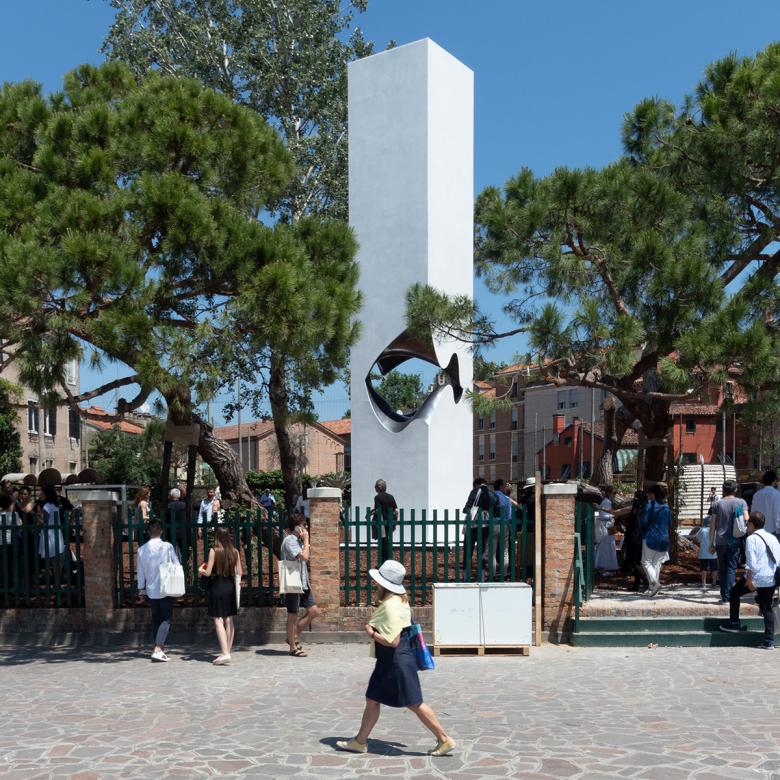Facing Gaia, an installation designed by Studio Libeskind, was unveiled in Giardini Marinaressa during the preview of the Venice Architecture Biennale last week. Part of the Time Space Existence exhibition, the rectilinear column punctured by an amorphous aperture was built with Grip Metal, whose mechanical bonding process reduces the weight of the installation and enabled its quick fabrication.
Location: Giardini Marinaressa, Venice
Client: European Cultural Centre
Architect: Studio Libeskind, New York
Design Principal: Daniel Libeskind
Manufacturer: GRIP Metal, A NUCAP Technology, Toronto
Product: Recylced wood veneer bonded with Grip Metal and finished with Venetian plaster
Daniel Libeskind unveiled the project on the Friday of the Biennale preview, drawing a large crowd of admirers that listened to the architect expound on the meaning of the installation. "It’s a marker," he said to them, "It’s an architectural sculpture. But what is it? And why?" The title Facing Gaia implies that it must relate to the earth and most likely our current climate crisis. The two parts of the piece – the void and the column – symbolize respectively space (“the biggest mouth that swallows us”) and our vertical orientation to the world around us. The void threatens to collapse the vertical dimension, just as climate change threatens our existence within the "thin veil of the atmosphere that we are dependent upon to breath and live."
Libeskind's intentions need not be understood to appreciate Facing Gaia. The relatively simple design takes on slightly different qualities from different angles, thanks mainly to the undulating surfaces of the void. The opening is high enough that we do not look through it to each other; instead our gaze locks on to the surrounding trees and buildings, but mainly to the sky: the thin atmosphere we depend upon for life. Libeskind told me after his remarks that its design is rooted in its place: "It’s the classical column that you see in Venice. It’s finished with Venetian plaster, very traditional." Furthermore, the void seems to reference the waves that sit just steps beyond the garden's gates.
In regard to materials, Libeskind told me, "We have to look at new materials, new possibilities technologically." Particular to Facing Gaia, the architect said Grip Metal "can eliminate a lot of weight from the structure – and it’s really a very big structure. It was a great collaboration with a company where we were able to really innovate in how something can be constructed lightweight, stable, and very robust – and to a setting that has to be transported across water."
Grip Metal, part of Nucap, might not be a familiar name to architects. That's because the technology – a stamping process for bonding materials together through rolls or sheets of metal – was first applied to brake pads in cars. After reportedly one billion automobile applications and not even one failure, the company has been looking to the construction industry for applications. Facing Gaia acts as an expression of what the technology is capable of – even if it is hidden behind the plaster that faces the column and below it, as the installation's foundation.
As Grip Metal's Derek Peper told me at the unveiling, the company's stamping technology brings up hooks through sheet metal and thereby facilitates a mechanical biting bond between materials (concrete, wood, resin, etc.). It is an alternative to glues, and in this case it was used with recylced wood veneer in place of traditional plywood: the walls of Facing Gaia were fabricated from four-sided boxes of Grip Metal bonded with layers of recycled wood veneer mounted on a stud frame. The walls are thinner than plywood and therefore lighter: 5 tons in total for the 12-meter-tall column. The height, originally 16 meters, was trimmed by 4 meters due to shipping constraints: the box-column was fabricated in Toronto (video below) and shipped via boat to Venice where it met the void (fabricated in The Netherlands) and was then lifted into place. On-site erection and finishing was eight days, while Grip Metal's fabrication took only two months. That's four months less than Grip Metal should have had, but the results hardly point to it being a rush job.





